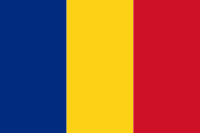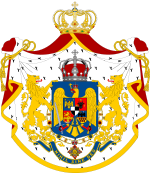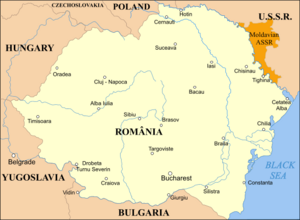Kingdom of Romania
|
|||||||||||||||||||||||||||||||||||||||||||||||||||
The Kingdom of Romania was the old Romanian state based on a form of parliamentary monarchy between 13 March 1881 and 30 December 1947, specified by the first three Constitutions of Romania (1866, 1923, 1938). Thus, the Kingdom of Romania began with the reign of King Carol I of Romania who gained Romanian's independence in the Romanian War of Independence, and ended with the abdication of King Michael I of Romania in 30 December 1947, imposed by the Soviet Union with the tacit and secret, implicit consent of its allies (as a result of the Yalta Conference and secret agreements). As such, it is quite distinct from the Romanian Old Kingdom, which refers strictly to the reign of King Carol I of Romania, between 13 March 1881 and 10 October 1914.
From 1859 to 1877, Romania evolved from a personal union of two vassal principalities (Moldavia and Wallachia) under a single prince to a full-fledged independent kingdom with a Hohenzollern monarchy. In 1918, at the end of World War I, Transylvania, Eastern Moldavia (Bessarabia), and Bukovina united with the Kingdom of Romania, resulting in a "Greater Romania". In 1940, at the beginning of World War II, Northern Transylvania, Basarabia and Cadrilater were ceded to Hungary, the Soviet Union and Bulgaria respectively, only Northern Transylvania being recovered after World War II ended. In 1947 the last king was compelled to abdicate and a republic ruled by the Romanian Communist Party replaced the monarchy.
Contents |
Unification and monarchy
| History of Romania | |
|---|---|
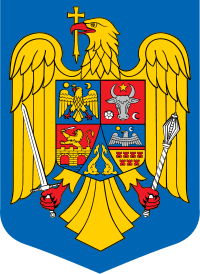 This article is part of a series |
|
| Prehistory | |
| Dacia | |
| Dacian Wars | |
| Roman Dacia | |
| Thraco-Roman syncretism | |
| Early Middle Ages | |
| Origin of the Romanians | |
| Middle Ages | |
| History of Transylvania | |
| Foundation of Wallachia | |
| Foundation of Moldavia | |
| Early Modern Times | |
| Principality of Transylvania | |
| Phanariotes | |
| Danubian Principalities | |
| National awakening | |
| Organic Statute | |
| 1848 Moldavian Revolution | |
| 1848 Wallachian Revolution | |
| United Principalities | |
| War of Independence | |
| Kingdom of Romania | |
| World War I | |
| Union with Transylvania | |
| Union with Bessarabia | |
| Greater Romania | |
| Soviet occupation of Bessarabia and Northern Bukovina | |
| World War II | |
| Communist Romania | |
| Soviet occupation | |
| 1989 Revolution | |
| Romania since 1989 | |
| Topic | |
| Timeline | |
| Military history | |
|
Romania Portal |
The 1859 ascendancy of Alexander John Cuza as prince of both Moldavia and Wallachia under the nominal suzerainty of the Ottoman Empire united an identifiably Romanian nation under a single ruler. On 5 February 1862 (24 January Old Style) the two principalities were formally united to form Romania, with Bucharest as its capital.
On 23 February 1866 a so-called Monstrous coalition, composed of Conservatives and radical Liberals, forced Cuza to abdicate. The German prince Carol (Charles) of Hohenzollern-Sigmaringen was appointed as Prince of Romania, in a move to assure German backing to unity and future independence. His clansmen were to rule as the kings of Romania until the rise of the communists in 1947.
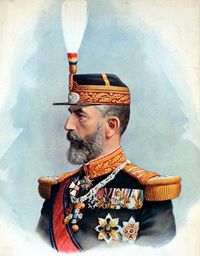
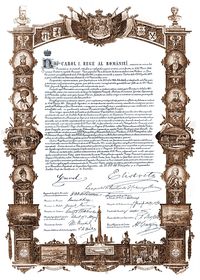
In 1877, following a Russian-Romanian-Turkish war, Romania was recognized as independent by the Treaty of Berlin, 1878, and acquired Dobruja, although it was forced to surrender southern Bessarabia (Budjak) to Russia. Charles was crowned as Carol, the first King of Romania, in 1881.
The new state, squeezed between the Ottoman, Austro-Hungarian, and Russian empires, with Slavic populations on its southwestern, southern and northeastern borders, the Black Sea due east, and Magyar neighbors on its western and northwestern borders, looked to the West, particularly France, for its cultural, educational and administrative models.
Abstaining from the Initial Balkan War against the Ottoman Empire, Romania entered the Second Balkan War in June 1913 against Bulgaria. 330,000 Romanian troops moved across the Danube and into Bulgaria. One army occupied Southern Dobrudja and another moved into northern Bulgaria to threaten Sofia, helping to bring an end to the war. Romania thus acquired the ethnically-mixed territory of Southern Dobrudja, which it had desired for years.
In 1916 Romania entered World War I on the Entente side, but was quickly defeated and occupied by German and Austro-Hungarian forces. Romania engages in a conflict against Bulgaria but as a result Bulgarian forces, after a series of successful battles, regain Dobruja that was previously taken from Bulgaria by the treaty of Bucharest and the Berlin congress. Although the Romanian forces did not fare well militarily, by the end of the war the Austrian and Russian empires were gone; governing bodies created in Transylvania, Bessarabia and Bukovina chose union with Romania, upheld in 1919 the Treaty of Saint-Germain and in 1920 by the Treaty of Trianon.
Romanian Old Kingdom (1881–1918)
The Romanian Old Kingdom (Romanian: Vechiul Regat or just Regat; German: Regat or Altreich) is a colloquial term referring to the territory covered by the first independent Romanian nation state, which was composed of the Danubian Principalities — Wallachia and Moldavia. It was achieved when, under the auspices of the Treaty of Paris (1856), the ad hoc Divans of both countries - which were under Imperial Ottoman suzerainty at the time - voted for Alexander John Cuza as their prince, thus achieving a de facto unification. The region itself is defined by the result of that political act, followed by the inclusion of Northern Dobruja in 1878, the proclamation of the Kingdom of Romania in 1881, and the annexation of Southern Dobruja in 1913.
The term came into use after World War I, when the Old Kingdom was opposed to Greater Romania, which included Transylvania, Banat, Bessarabia, and Bukovina. Nowadays, the term mainly has a historical relevance, and is otherwise used as a common term for all regions in Romania included in both the Old Kingdom and present-day borders (namely: Wallachia, Moldavia, and Northern Dobruja).
World War I
Romania delayed in entering World War I, but ultimately declared war on the Central Powers in 1916. The Romanian military campaign ended in disaster when the Central Powers quickly crushed the country's armed forces and occupied most of the country, including the strategically important oil fields. But after the war ended, Romania's government quickly reasserted control and put an army back into the field. Transylvania was soon overrun, as was Moldavia, since the power vacuum in Russia caused by the civil war there allowed Romania to assert its claims over that territory. War with Hungary in 1919 resulted in the occupation of Budapest by Romanian troops.
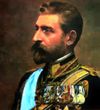
Union with Transylvania, Bessarabia and Bukovina

After World War I, during 1918, Transylvania, part of Banat, Bessarabia (Eastern Moldavia between Prut and Dniester rivers) and Bukovina united with Romania. Except for some territories across the Dniester river, all these territories were united in a single state. Thus, Romania in 1919 was more than twice the size it had been in 1914. Although the country was satisfied and had no further territorial claims, it aroused the enmity of Bulgaria, and especially Hungary and the Soviet Union.
Greater Romania now encompassed a significant minority population, especially of Maygars, and faced the difficulty of assimilation. By contrast, the prewar Romanian state had only one real minority, Jews, but nonetheless anti-Semitism was widespread.
Romania was typical of states in Eastern Europe in that it primarily served as a source of raw materials for the West. Mines and oil wells were largely owned and operated by foreign outfits, and their output almost entirely exported. Oil in particular was a valuable commodity, although not as much as it would be in the second half of the 20th century.
The peasant population was among the poorest in the region, a situation aggravated by one of Europe's highest birth rates. As elsewhere, peasants everywhere were convinced that land reform would solve their problems, and after the war they began to clamor loudly for such action. Communist groups began taking advantage of the situation, which led to the government breaking up estates in 1920. But it did precious little to improve productivity, especially since the richness of Romania's soil was negated by a lack of modern farming techniques. Agricultural exports could not compete with those of Western Europe and North America, and the onset of the Great Depression caused the market for them to completely dry up.
By the 1920 Treaty of Trianon, Hungary renounced in favor of Romania all the claims of the Austro-Hungarian Monarchy over Transylvania.[1] The union of Romania with Bukovina was ratified in 1919 in the Treaty of Saint Germain,[2] and in 1920 a part of the Western powers recognized Romanian rule over Bessarabia by the Treaty of Paris.[3]
The interregnum years
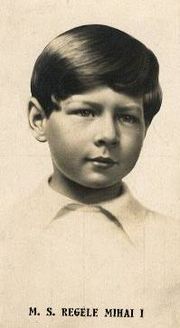
The Romanian expression România Mare (literal translation "Great Romania", but more commonly rendered "Greater Romania") generally refers to the Romanian state in the interwar period, and by extension, to the territory Romania covered at the time (see map). Romania achieved at that time its greatest territorial extent (almost 300,000 km² [4]). At the 1930 census, there were over 18 million inhabitants in Romania.
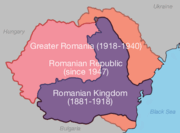
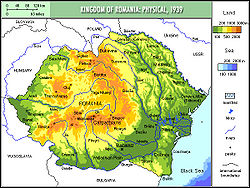
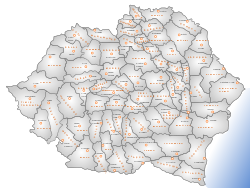
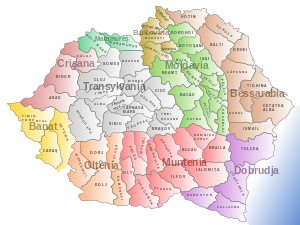
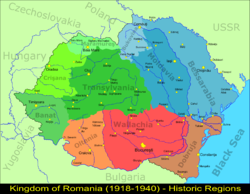

The resulting "Greater Romania" did not survive World War II. Until 1938, Romania's governments maintained the form, if not always the substance, of a liberal constitutional monarchy. The National Liberal Party, dominant in the years immediately after World War I, became increasingly clientelist and nationalist, and in 1927 was supplanted in power by the National Peasant Party. Between 1930 and 1940 there were over 25 separate governments; on several occasions in the last few years before World War II, conflict between the Iron Guard and other political groupings approached the level of a civil war.
Upon the death in 1927 of his father Ferdinand, Prince Carol was prevented from succeeding him because of previous marital scandals that had resulted in his renunciation of rights to the throne. After serving three years in exile, with his brother Nicolae serving as regent and his young son Michael as king, Carol changed his mind and with the support of the ruling National Peasant Party he returned and proclaimed himself king.
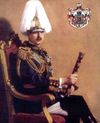
Iuliu Maniu, leader of the National Peasant Party, engineered Carol's return on the understanding that he would forsake his mistress Magda Lupescu, and Lupescu herself had agreed to the arrangement. However, it became clear upon Carol's first re-encounter with Elena that she had no interest in a reconciliation, and Carol soon arranged for Lupescu's return to his side. Her unpopularity in Romania, no doubt due in large part to her having a Jewish father, was to be a millstone around Carol's neck for the rest of his reign, particularly because she was widely viewed as his closest advisor and confidante.
The 1929 economic crisis greatly affected Romania and the early 1930s were marked by social unrest, high unemployment, and strikes. In several instances, the Romanian government violently repressed strikes and riots, notably the 1929 miners' strike in Valea Jiului and the strike in the Griviţa railroad workshops. In the mid-1930s, the Romanian economy recovered and the industry grew significantly, although about 80% of Romanians were still employed in agriculture.
As the 1930s progressed, Romania's already shaky democracy slowly deteriorated toward fascist dictatorship. The constitution of 1923 gave the king free rein to dissolve parliament and call elections at will; as a result, Romania was to experience over 25 governments in a decade.
Increasingly, these governments were dominated by any of a number of anti-Semitic, ultra-nationalist, and mostly at least quasi-fascist parties. The National Liberal Party steadily became more nationalistic than liberal, but nonetheless lost its dominance over Romanian politics. It was eclipsed by parties like the (relatively moderate) National Peasant Party and its more radical Romanian Front offshoot, the League of National-Christian Defense (LANC) and the Iron Guard. In 1935 LANC merged with the National Agrarian Party to form the National Christian Party (NCP). The quasi-mystical fascist Iron Guard was an earlier LANC offshoot that, even more than these other parties, exploited nationalism, fear of communism, and resentment of alleged foreign and Jewish domination of the economy.
Already, the Iron Guard had embraced the politics of assassination and various governments had reacted more or less in kind. On December 10, 1933, Liberal prime minister Ion Duca "dissolved" the Iron Guard, arresting thousands; 19 days later he was assassinated by Iron Guard legionnaires.
Throughout the 1930s, these nationalist parties had a mutually distrustful relationship with King Carol II. Nonetheless, in December 1937, the king appointed LANC leader (and poet) Octavian Goga as prime minister. Around this time, Carol met with Adolf Hitler, who expressed his wish to see a Romanian government headed by the Iron Guard. Instead, on 10 February 1938 King Carol II used the occasion of a public insult by Goga toward Lupescu as a reason to dismiss the government and institute a short-lived royal dictatorship, sanctioned seventeen days later by a new constitution under which the king named not only the prime minister but all ministers.
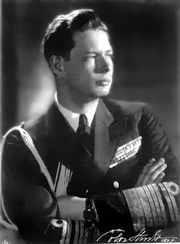
On 10 February 1938, in order to prevent the formation of a government that would have included Iron Guard ministers, and in direct confrontation to Adolf Hitler's expressed support of the Iron Guard, King Carol II dismissed the government and instituted a short-lived royal dictatorship, raising the stakes on both sides. In April 1938, Carol had Iron Guard leader Corneliu Zelea Codreanu arrested and imprisoned. On the night of 29-30 November 1938, Codreanu and several other legionnaires were killed while purportedly attempting to escape from prison. It is generally agreed that there was no such escape attempt, but that they were murdered in retaliation for a series of assassinations by Iron Guard commandos.
The royal dictatorship was brief. On 7 March 1939 a new government was formed with Armand Călinescu as prime minister; on 21 September 1939, three weeks after the start of World War II, Călinescu, in turn, was assassinated by legionnaires avenging Codreanu.
In 1939 Germany and the Soviet Union signed the Molotov-Ribbentrop Pact, which stipulated, among other things, the Soviet "interest" in Basarabia.
Timeline (1859 - 1939)
| 1859 | Alexander John Cuza unites Moldavia and Wallachia under his personal rule. |
| 1862 | Formal union of Moldavia and Wallachia to form principality of Romania. |
| 1866 | Cuza forced to abdicate and a foreign dynasty is established. Carol I signed the first modern Constitution. |
| 1877 | April 16. Treaty by which the Russian troops are allowed to pass through Romanian territory
April 24. Russia declares war to the Ottoman Empire and its troops enter Romania |
| 1878 | Under Treaty of Berlin, Ottoman Empire recognizes Romanian independence. Romania ceded southern Bessarabia to Russia. |
| 1881 | Carol I was proclaimed King of Romania on March 26. |
| 1894 | Leaders of the Transylvanian Romanians who sent a Memorandum to the Austrian Emperor demanding national rights for the Romanians are found guilty of treason. |
| 1907 | Violent peasant revolts crushed throughout Romania, thousands of persons killed. |
| 1914 | Death of Carol I, succeeded by his nephew Ferdinand. |
| 1916 | (August) Romania enters World War I on the Entente side. (December) Romanian Treasure sent to Russia for safekeeping, but was seized by Soviets after the Romanian army refused to withdraw from Bessarabia. |
| 1918 | Greater Romania is created. |
| By the Treaty of Versailles, Romania agreed to grant citizenship to the former citizens of Russian and Austro-Hungarian empires living in the new Romanian territories. | |
| 1919 | A military conflict occurs between Romania and Hungarian Soviet led by Béla Kun. The Romanian Army takes over Budapest on 4 August 1919. The city is ruled by a military administration until 16 November 1919. |
| 1920 | The Treaty of Trianon upholds Romanian unification. |
| 1921 | A major and radical agrarian reform. |
| 1923 | The 1923 Constitution is adopted based on a National Liberal Party project. Christian National Defense League (LANC) founded. |
| 1924 | LANC member (later Iron Guard founder) Corneliu Zelea Codreanu assassinates the Prefect of Police in Iaşi, but is acquitted. |
| 1926 | Liberal Electoral Law adopted. "Little Entente" with Czechoslovakia and Yugoslavia and Franco-Romanian Treaty. |
| 1927 | The National Peasant Party takes over the government from the National Liberal Party. The Legion of the Archangel Michael, later the Iron Guard, splits from LANC. |
| 1929 | Beginning of the Great Depression. |
| 1930 | Carol II crowned King. |
| 1931 | First ban on Iron Guard. |
| 1933 | (16 February) Griviţa Railcar Workshops strike violently put down by police. (10 December) Prime Minister Ion Duca "dissolves" the Iron Guard, arresting thousands; 19 days later he is assassinated by Iron Guard legionnaires. |
| 1935 | LANC and National Agrarian Party merge to form the fascist National Christian Party (NCP). |
| 1937 | Electoral "non-aggression pact" between National Peasant Party and Iron Guard, later adding the Agrarian Union. Romanian Communist Party denounces pact, but, in practice, supports the National-Peasants. LANC forms government, but is rapidly in conflict with Carol II over his Jewish mistress. |
| 1938 | 10 February. Royal dictatorship declared. New constitution adopted 27 February. (29-30 November) Iron Guard leader Codreanu and other legionnaires shot on the King's orders. |
| 1939 | 7 March. Armand Călinescu forms government. 23 August. Molotov-Ribbentrop Pact stipulates Soviet "interest" in Bessarabia. |
References
- Lampe, John R. Balkan Economic History, 1550–1950: From Imperial Borderlands to Developing Nations, 1982, ISBN 0253303680.
- ↑ "Text of the Treaty of Trianon". World War I Document Archive. http://wwi.lib.byu.edu/index.php/Treaty_of_Trianon. Retrieved 2007-12-07.
- ↑ Bernard Anthony Cook (2001). Europe Since 1945: An Encyclopedia. Taylor&Francis. p. 162. ISBN 0815340575. http://books.google.com/?id=ox_gXq2jpdYC&pg=PA162&lpg=PA162&dq=treaty+of+st+germain+text+bukovina. Retrieved 2007-12-07.
- ↑ Malbone W. Graham (October 1944). "The Legal Status of the Bukovina and Bessarabia" (– Scholar search). The American Journal of International Law (American Society of International Law) 38 (4). http://www.jstor.org/view/00029300/di981654/98p0431z/2?frame=noframe&[email protected]/01c0a80a6a00501cd629c&dpi=3&config=jstor. Retrieved 2007-12-08.
- ↑ (Romanian)STATUL NATIONAL UNITAR (ROMÂNIA MARE 1919 - 1940)
See also
- Romanian War of Independence
- Video with the redrawing of the borders after the First World War
- Romanian Tourism Map from 1938
|
||||||||||||||||||||||||||||||||||||||||||||||||
